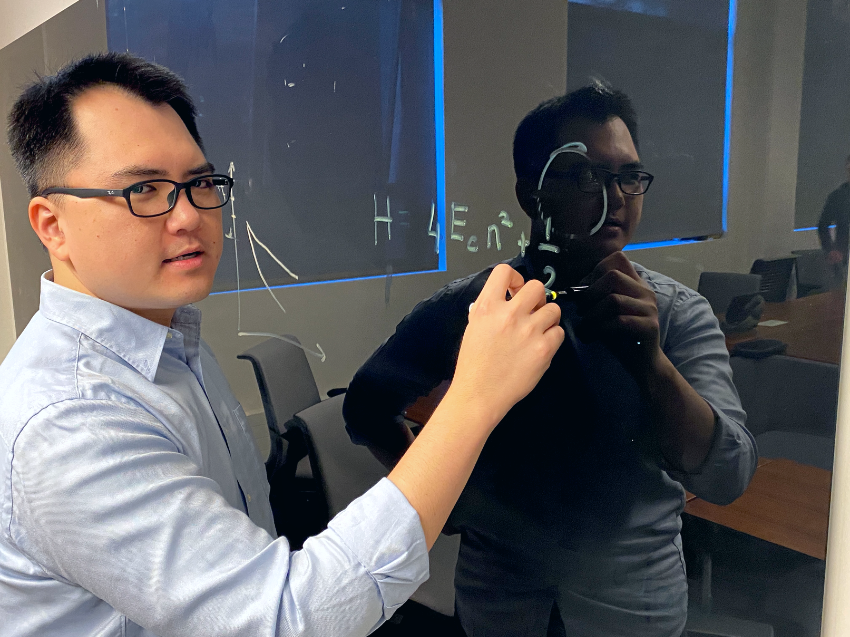The next generation of quantum devices requires high-coherence qubits that are less error-prone. Responding to this need, researchers at the Advanced Quantum Testbed (AQT) at Berkeley Lab, a state-of-the-art collaborative research laboratory funded by the U.S. Department of Energy Office of Science, developed a blueprint for a novel quantum processor based on “fluxonium” qubits. Fluxonium qubits can outperform the most widely used superconducting qubits, offering a promising path toward fault-tolerant universal quantum computing.
In collaboration with researchers from the University of California, Berkeley, and Yale University, the AQT team pioneered a systematic theoretical study of how to engineer fluxonium qubits for higher performance while offering practical suggestions to adapt and build the cutting-edge hardware that will fully harness the potential of quantum computing. PRX Quantum published their results in August 2022.

On the Leading Edge of Superconducting Processors
Superconducting quantum processors consist of multiple qubits designed to have different transition frequencies facilitating precise control of individual qubits and their interactions. The transmon qubit, one of the most widely used in the field for superconducting processors, typically has low anharmonicity. Anharmonicity is the difference between relevant transition frequencies in a qubit. Low anharmonicity contributes to spectral crowding (when qubit frequencies are close to resonating with each other), making the processor more difficult to control since qubit frequencies are arranged tightly together. In contrast, high anharmonicity allows researchers to have better qubit control because there’s less overlap between the frequencies that control the qubits and those that drive any given qubit to higher energy levels. The fluxonium qubit has inherent advantages for complex superconducting processors, such as high anharmonicity, long coherence times, and simple control.
Building on AQT’s robust research and development history on superconducting circuits, the team leading the fluxonium-based architecture focused on the scalability and adaptability of the processor’s main components, with a set of parameters that researchers can tune to increase the runtime and fidelity of quantum circuits. Some of these adaptations allow simpler operation of the system. Researchers proposed, for example, controlling the fluxonium qubits at low frequency (1-GHz) via microwave pulses directly generated by an electrical arbitrary waveform generator. This straightforward approach allows researchers to design processors and set up multiple qubits flexibly.
Flexible Approaches With Fluxonium Qubits for Large-Scale Devices
Long B. Nguyen is a project scientist at AQT and the paper’s lead author. Nguyen started researching alternative superconducting qubits as a University of Maryland graduate student working with Professor Vladimir Manucharyan. Manucharyan introduced fluxonium qubits to the field just a decade earlier, and in 2019 Nguyen demonstrated the possible longer coherence times with fluxonium circuits. The fluxonium circuit is composed of three elements: a capacitor, a Josephson Junction, and a superinductor, which helps suppress magnetic flux noise – a typical source of unwanted interference that affects superconducting qubits and causes decoherence.
“I always wanted to study new physics, and I focused on fluxonium because it appeared to be a better alternative to the transmon at the time. It has three circuit elements that I could play with to get the type of spectra I wanted. It could be designed to evade decoherence due to material imperfections. I also recently realized that scaling up fluxonium is probably more favorable since the estimated fabrication yield is high, and the interactions between individual qubits can be engineered to have high-fidelity,” explained Nguyen.

To estimate and validate the performance of the proposed fluxonium blueprint, the team at AQT, in collaboration with the paper’s researchers, simulated two types of programmable quantum logic gates – the cross-resonance controlled-NOT (CNOT) and the differential ac-Stark controlled-Z (CZ). The high fidelities resulting from the gates’ simulation across the range of proposed qubit parameters validated the team’s expectations for the suggested blueprint.
“We provided a potential path towards building fluxonium processors with standard, practical procedures to deploy logic gates with varying frequencies. We hope that more R&D on fluxonium and superconducting qubit alternatives will bring about the next generation of devices for quantum information processing,” said Nguyen.

Founded in 1931 on the belief that the biggest scientific challenges are best addressed by teams, Lawrence Berkeley National Laboratory and its scientists have been recognized with 16 Nobel Prizes. Today, Berkeley Lab researchers develop sustainable energy and environmental solutions, create useful new materials, advance the frontiers of computing, and probe the mysteries of life, matter, and the universe. Scientists from around the world rely on the Lab’s facilities for their own discovery science. Berkeley Lab is a multiprogram national laboratory, managed by the University of California for the U.S. Department of Energy’s Office of Science.
DOE’s Office of Science is the single largest supporter of basic research in the physical sciences in the United States, and is working to address some of the most pressing challenges of our time. For more information, please visit energy.gov/science.
